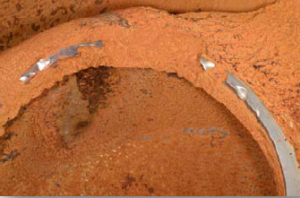What Are Common Severe Service Applications?
Many process applications require specific materials and characteristics to meet industry standards for Severe Service. In this post we will review common severe service applications*.

ASME’s Category M Service Dangerous fluid service is defined in ASME B31.3, Process Piping and is called Category M Service.
- A fluid service in which the potential for personal exposure is judged to be significant and in which a single exposure to a very small quantity of toxic fluid, caused by leakage, could produce irreversible harm to persons on breathing or bodily contact, even when prompt restorative measures are taken.
There are also other interpretations, as some end-users define dangerous fluids as:
- Toxic materials such as:
- Phenol, Hydrogen Sulfide and Chlorine
- Highly corrosive materials such as acids and caustic
- Ex. HF Alkylation service is considered a critical service. It is an acid that vaporizes at 67 degrees F and is very corrosive. One drop can eat through your skin and the vapors will destroy your lungs.
- Flammable materials, including light hydrocarbons
- Boiler feed-water and steam requiring class 300 ratings and higher
- Oxygen in concentrations greater than 35%
Other factors determining critical service are difficulty in the sealability of some medias, as well as high-temperature applications. Includes mining and slurries Very high temperature media are also considered critical service applications. Flue gas or catalyst injection.
Some common critical service applications:
- Application: Nuclear Why Critical Service?: Oxygen
- Application: Hydrogen Why Critical Service?: Highly Corrosive
- Application: Hydrogen Sulfide Why Critical Service? : Emergency Shutdown
- Application: Chlorine Why Critical Service?: Flammable Fluids
Nuclear Applications
Nuclear electric generation plants are considered a critical service application due to the risk of equipment failure that could lead to exposure from radiation escaping containment. This application has very strict valve standards, codes and guidelines. Such as:
- Near perfect casting requirements
- Extremely tight quality requirements for nuclear valve manufacturers
- Repair requiring ASME certification N – Stamp
Hydrogen Applications
Maintaining containment of gases, such as hydrogen, has an impact on materials and safety to keep personnel safe.
- Very small molecule size of hydrogen requires forgings or high quality castings
- Hydogren gas is highly inflammable
- Hydrogren corrosion can be an issue
- Governed by ASME B31.12-2008.
Hydrogen Sulfide Applications
Sour gas, or hydrogen sulfide is another application that can be hazardous to your health in certain concentrations. This sour gas can be found in some crude oils, from the well through the refining stages.
- Prolonged low-level exposure destroys sense of smell
- High ppm concentrations have no odor
- Levels about 100 ppm are dangerous to life and health
- H2S is highly corrosive
- Valve Material specifications are covered by NACE international standards
- MRO 175 Upstream applications
- MRO 103 Downstream Refining applications
Chlorine Applications
Chlorine is another corrosive application where materials and proper equipment are crucial for public safety.
- Lethal in concentrations of 35-50 ppm
- Chlorine Institute issues guidelines for valves in chlorine service including those used on railroad tank cars
Oxygen Applications
Oxygen in itself is not dangerous, but when in service with other flammable material it can become dangerous.
- Supports combustion
- Makes any flammable material burn intensely
- Can cause combustion hot enough to melt metals
- Valves in Oxygen service must be completely free of all oils and grease
- Oxygen Service Standards and Specifications are provided by:
- Compressed Gas Association (CGA)
- National Fire Protection Association (NFPA)
- ASTM International
Highly Corrosive Media Applications
Primarily acids and caustics, highly corrosive media presents its own challenges within applications. If the wrong material is chosen for corrosive service, some corrosives can eat though the base metal in a matter of hours. Therefore, proper material selection throughout the entire assembly is key. Valve Trims are often more susceptible to corrosion with the addition of velocity-based erosion.
Emergency Shutdown Valves (ESV) or Emergency Isolation Valves (EIV)
Many critical pant applications utilize ESV or EIV valves. These valves must always work when required, and are usually a block valve that can be closed either by hand or automated. ESVs are a requirement at all intervals in flammable service transport pipelines.
Flammable Fluid Applications
All flammable fluids are normally considered a critical service applications. All hydrocarbons are flammable fluids. As a result the most common concern is leakage pasted a closed valve, sometimes do to corrosion or erosion. Research into flammable fluid control has led the way fro new valve designs.
With a variety of different packages to choose from, Setpoint Integrated Solutions has the appropriate specifications to meet your needs. Contact us today
*This post was adapted from content created by VMA at their Valve Basics Course, found here



